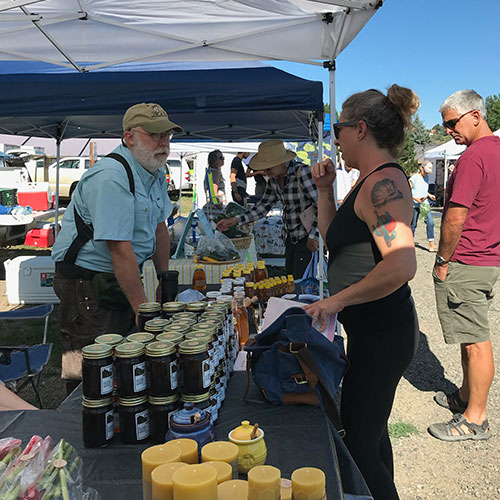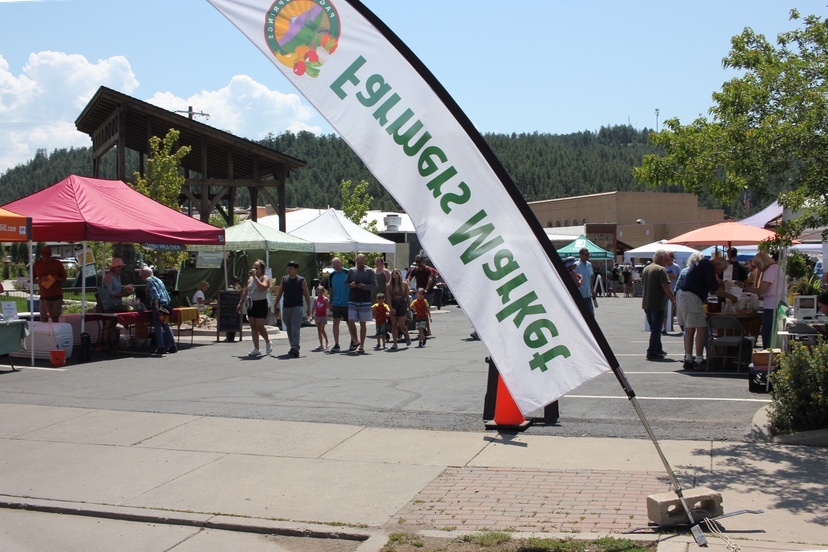Heading for the grocery store on Saturday morning to buy another bag of ground coffee, I noticed, within the first few moments of my outing, several life forms. A grasshopper on my front steps, jumping out of my way. A few birds flitting across the sky. A small herd of deer — young bucks, with freshly-sprouted antlers — looking up from their grazing activities as I drove past.
It seems to me that the deer on my neighborhood spend most of the day eating. Ditto, the grasshoppers, and the birds.
As I turned onto Lewis Street, low and behold, the Pagosa Farmers Market was in full swing in the Tennyson Sculpture Park. The life forms visiting the Market were presumably shopping for things to eat. Just like the grasshoppers, and the birds and the young bucks, humans require a regular intake of food. Perhaps too much food, sometimes.
Eating is definitely a popular activity, for so many reasons.

In Part Four, I mentioned an editorial published in ‘On Land’ magazine, written by Western Land Alliance CEO Lesli Allison, sharing her ideas about reversing the aridification of the American West, through agricultural practices.
Ms. Allison submitted a letter that we posted this morning, clarifying the central point she was trying to make in her editorial. You can read her response here.
Disclosure: I currently serve as a volunteer on the Pagosa Area Water and Sanitation District (PAWSD) Board of Directors, but this editorial reflects only my own personal opinions and not necessarily the opinions of the PAWSD Board as a whole.
In the current contest for water resources in the American West — I wouldn’t call it a “war” exactly, but definitely a contest — some players are arguing that we (as in, we the taxpayers) need to pay farmers and agricultural corporations to stop irrigating their crops, to allow the water to be used instead by city dwellers and recreationalists.
When Northern European colonists and their descendants began moving west from the initial East Coast settlements, into the Midwest and Great Plains, about 90% of the nation’s families lived as farmers. Unfortunately for the environment, most of the farmers knew very little about sustainable farming. When they depleted the soil in Ohio, they sold their farm and moved to Indiana, and then Iowa, and then Kansas, and ultimately to Colorado and the rest of the American Southwest, depleting the soil as they went.
In most cases, they brought along their wives and children.

At Saturday’s Farmer’s Market, I had a short but interesting conversation with one of the vendors, about water and agriculture. He happened to mention the New Mexico Acequia Association.
Arriving in the Southwest in the late 1880s, the new settlers met up with Native American tribes — some of whom had been farming sustainably for millennia — and with the Spanish colonists, who had been around for three centuries and had developed a vibrant culture around the acequias, a community-operated watercourse used in Spain, northern Mexico, and the modern-day American Southwest. In the U.S., the oldest acequias were established more than 400 years ago.
The word derives from the Arabic word al-sāqiyah which can mean “one that bears water” as well as “bartender”.
Acequias are designed, maintained, and operated to meet a variety of productive goals and social needs, with the practice of irrigated agriculture being of paramount importance. The customary ‘law of the acequia’ is older than — and at variance with — the Doctrine of Prior Appropriation that typically governs water rights in Colorado and much of the American Southwest.
The Doctrine of Prior Appropriation is based on the principle of “first in use, first in right”, which pits water users against one another, based on who started using a particular water source first, second, third, etc. In a situation where a water shortage exists, the senior user can demand that junior users stop irrigating to provide the senior user with access to their entire water right. This has resulted in an unfortunate system where a water rights owner must consume their entire right each year, or risk losing the portion they don’t use.
Acequia law, by comparison, incorporates not just priority but principles of equity and fairness, by treating water as a community resource that irrigators have a shared right to use, manage, and protect. The concept of a shared responsibility for natural resources reflects beliefs stemming from the Spanish and Indigenous cultures.
But pressure is growing in the American West to view water as a commodity… as something to sell… rather than as the glue that holds together a traditional agriculture-based society.
Here’s a 2-minute excerpt from a film trailer for “Acequias:The Legacy Lives On”, produced by the Center for Regional Studies at the University of New Mexico.
You can watch the entire one-hour documentary here.
Although you can purchase some locally-grown specialty items at the Pagosa Springs Farmers Market — heirloom tomatoes, for example, and grass-fed beef and pork — the majority of food items available in Pagosa grocery stores are produced by corporations. In some cases, by multinational corporations. We can assume that the lobbyists hired by these corporations are playing an outsized role in the political decisions made in Denver and Washington DC.
One example might be the decision to pay farmers in California’s Imperial Valley $700 per acre-foot of irrigation water they don’t use. This irrigation water doesn’t actually “belong” to the Imperial Valley corporations; they’ve merely been given permission to use it, by a complex legal system. But apparently, they can sell a promise not to use water granted to them as a gift. And they can sell that promise to the citizens who provided the gift.
Some water decisions, meanwhile, are being made closer to home, by local government boards.
I hinted at one of those water resource decisions, back in Part One. And I expect to learn more about how decisions are being made, today, Monday, at the 4pm ‘special’ meeting of the San Juan Water Conservancy District, at their district office.

